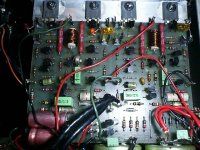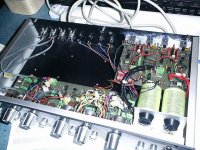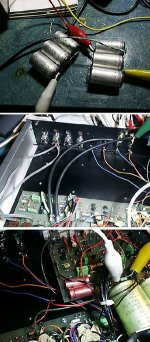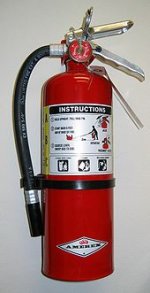I'm thinking of resoring an old amp that my father built in the 60's I think (when he was a student).
Then it sounded just fine but as I hooked it up just now, there is alot of humm. So decided to start replacing some components and maybe it will sound decent again!
I'd start of with some of the electrolytic caps, mains, filter etc. And maybe the turning knobs ( potentiometers) aswell. But I really don't know weather there's anything else that I should replace? Since it has not been in use for a very long time, I don't think that anything else has aged, or am I wrong?
The mains-cable is not grounded, maybe I could ground the thing better with a modern cable?
Also, since I dont know the design and I'm not out to make big expensive changes to it, what small things could I do to improve the output signal a bit. I am happy to supply pics of anything on this amp, so juste say so and I'll post em!
Any answer are very welcome!
Best Regards, Chris
(In the pictures you see the entire thing and the closeup is on the mainboard, the other pcb is just for filters and stuff. Under the mainboard is the xfomer. Dont mind the LEDs in the place of the fuses, just me playing around and it makes no difference without them. There used to be a radio-pcb in the box also, but I removed it.
Then it sounded just fine but as I hooked it up just now, there is alot of humm. So decided to start replacing some components and maybe it will sound decent again!
I'd start of with some of the electrolytic caps, mains, filter etc. And maybe the turning knobs ( potentiometers) aswell. But I really don't know weather there's anything else that I should replace? Since it has not been in use for a very long time, I don't think that anything else has aged, or am I wrong?
The mains-cable is not grounded, maybe I could ground the thing better with a modern cable?
Also, since I dont know the design and I'm not out to make big expensive changes to it, what small things could I do to improve the output signal a bit. I am happy to supply pics of anything on this amp, so juste say so and I'll post em!
Any answer are very welcome!
Best Regards, Chris
(In the pictures you see the entire thing and the closeup is on the mainboard, the other pcb is just for filters and stuff. Under the mainboard is the xfomer. Dont mind the LEDs in the place of the fuses, just me playing around and it makes no difference without them. There used to be a radio-pcb in the box also, but I removed it.
Attachments
Hi Christian
Yup electrolytics would be a good start, this could be the cause of the hum problems if they have dried out, pots maybe if they are noisy, otherwise just leave them. Everything else should be fine unless you have problems, as if you start changing many components you might as well just build a new amp.
 Grounding is essential for safety, so should be a priority
Grounding is essential for safety, so should be a priority
Yup electrolytics would be a good start, this could be the cause of the hum problems if they have dried out, pots maybe if they are noisy, otherwise just leave them. Everything else should be fine unless you have problems, as if you start changing many components you might as well just build a new amp.
 Grounding is essential for safety, so should be a priority
Grounding is essential for safety, so should be a priority
Okay! So I shouldn't replace all those small caps ( the green ones) because I don't know which dielectric and I can't measure them.
Then I'm thinking of replacing the rectifier diods and add small cap across each. Maybe even replace allt the cables to ground-shilded ones and solder the connectors?
A note on grounding ; There's quiet alot of extra hum when I grund the case, maybe grounding it's not such a good idea?
Best Regards
/Chris
Then I'm thinking of replacing the rectifier diods and add small cap across each. Maybe even replace allt the cables to ground-shilded ones and solder the connectors?
A note on grounding ; There's quiet alot of extra hum when I grund the case, maybe grounding it's not such a good idea?
Best Regards
/Chris
Replacements
Your dad seems to have done a good job. The pcb is fiberglass, which must have been expensive in the 60s. And the capacitors seem to be good quality types. No ceramics around, apparently.
The green ones should be polyester, which are not that bad, and there are plenty of polystyrenes, which are excellent. Electrolytics are Roederstein, also quite good. All 'lytics should be changed though, for Panasonic types at least.
Resistors are not that good, looking like 10% carbon types. Perhaps the feedback resistors should be upgraded to something better.
The trimpots should be changed, I think, using multiturn sealed types. But for that you should measure the voltage between the output emitter resistors so as to put the same bias.
The diodes on board could be replaced for Schottky or fast types. But if the main bridge is fine and works cool it shouldn't be a priority.
Also have a look at the volume and balance pots, as they might upgraded to Alps or Noble.
The grounds might need a re-arrangement, but for that you should look carefully what's connected where on the board. In the 60s the star ground arrangement wasn't much used, and a star might be what you need.
Carlos
Christian said:Okay! So I shouldn't replace all those small caps ( the green ones) because I don't know which dielectric and I can't measure them.
Then I'm thinking of replacing the rectifier diods and add small cap across each. Maybe even replace allt the cables to ground-shilded ones and solder the connectors?
A note on grounding ; There's quiet alot of extra hum when I grund the case, maybe grounding it's not such a good idea?
Your dad seems to have done a good job. The pcb is fiberglass, which must have been expensive in the 60s. And the capacitors seem to be good quality types. No ceramics around, apparently.
The green ones should be polyester, which are not that bad, and there are plenty of polystyrenes, which are excellent. Electrolytics are Roederstein, also quite good. All 'lytics should be changed though, for Panasonic types at least.
Resistors are not that good, looking like 10% carbon types. Perhaps the feedback resistors should be upgraded to something better.
The trimpots should be changed, I think, using multiturn sealed types. But for that you should measure the voltage between the output emitter resistors so as to put the same bias.
The diodes on board could be replaced for Schottky or fast types. But if the main bridge is fine and works cool it shouldn't be a priority.
Also have a look at the volume and balance pots, as they might upgraded to Alps or Noble.
The grounds might need a re-arrangement, but for that you should look carefully what's connected where on the board. In the 60s the star ground arrangement wasn't much used, and a star might be what you need.
Carlos
Hey Carlos, thanks for the tips!!!
I've done some testing now, I added 3000 microF / voltage rail (some rifas I had) and hooked up the input with some better connector and cabel (pic)
Next thing will be changing those red electrolytics (rated 470 micro 16 volts)
I still have this buzz though, in particular in one channel, so should I remove the old main lytics (big yellow ones) completely?
Thanks for all the answers
/Chris
I've done some testing now, I added 3000 microF / voltage rail (some rifas I had) and hooked up the input with some better connector and cabel (pic)
Next thing will be changing those red electrolytics (rated 470 micro 16 volts)
I still have this buzz though, in particular in one channel, so should I remove the old main lytics (big yellow ones) completely?
Thanks for all the answers
/Chris
Attachments
Well, I really don't like to revive old and outdated threads, but I have come across some new trouble 
The amp is working fine now, except for a very clear turnoff-bump, but I can't connect some small caps across the bigger mains-filter caps because it generates a very loud humm. By humm I mean you almoste can't hear the music anymore when I place a small 0,1 micro across the mains filter.
Why is this? Btw I covered the x-former in some old clothe, because it was vibrating enough to make the entire case vibrate. Perhaps not such a good idea? but it seems to help.
Best Regards,
/Chris
The amp is working fine now, except for a very clear turnoff-bump, but I can't connect some small caps across the bigger mains-filter caps because it generates a very loud humm. By humm I mean you almoste can't hear the music anymore when I place a small 0,1 micro across the mains filter.
Why is this? Btw I covered the x-former in some old clothe, because it was vibrating enough to make the entire case vibrate. Perhaps not such a good idea? but it seems to help.
Best Regards,
/Chris
Condensers, the electrolitics suffer from agging, also our ears
changes when we become old, also our beliefs make us think everything goes agging in electronics....not real...more myth than reality.
I have transistors, germanium ones, operating since the sixties, and perfectly, also resistances that still the same, also capacitors..but condensers goes agging, need replacement..also transformer varnish and insulating, also oxide into connections, connectors and switchers, also potentiometers goes producing troubles...but really...we turn old..... electrons continues fine, and electronics use to remain fine too.
People replace all capacitors by fashion models and brands, because they "believe" this produces an effect in sonics.....negative!...do one channel and compare with the other one keept standard.....no modification you will be able to listen..also...people use to say the modified. sounded better...this happens because, in advance, previously, they have decided that..and we "make our minds" the way we want......all illusions.
Also,probably, our son is not beautifull, also our woman is not the best wife in the town, also we are not the most beautifull and clever guys in this planet (your mother believe that!)....those things are only beliefs that some of us have... called self steem by some folks.
Germanium transistors has leakage, means you can measure some resistance from colector to emitter...and i remember i painted the leakage numbers fourty years ago..and i have checked..after work for more than 40 years..the leakage is the same as new, also the gain remains in 32....exactly alike when was brand new....so...as was operating into a portable Telefunken radio, that agging in transistors does not exist, even when bad and old Germanium transistors...checked capacitors too..nothing wrong with their value or sound.
If you have never listened, or readed, the "King new clothes tale"... search for that tale that teaches a lot about human behavior, and our own way of thinking, our beliefs and what some repair man can do, or can say, to convince you to replace all capacitors.
It is easy to the one refurbish your amplifier.... you will pay a lot of money for nothing... and if your belief is really strong, after that modifications, you will think, believe and even listen that something has changed..then the King new clothers tale will show it's validity till our modern days.
Once i had a capacitor a yellow capacitor, and them i replaced by a french black one, and this resulted great...you see how simple and easy is to fool ourselves..i was fooling myself too....and i started to believe capacitors sounds (i was wrong)...latter that, i discovered, replacing the black one by several others, that they sounded the same...the earlier condenser, the former one into the circuit was defective..capacitance was wrong...had some leakage, had resistance.
To sound better compared to a defective one..well..this happens..but not true that some capacitor sounds better... replacing a defective by a good one, a non defective one, then you will have differences.
The black gates owner said...pay what i am asking for...them go to you home and go sitted waiting...one day will sound good.
Old times condenser had values different from the value printed.....more or less....some had more, and others had less capacitance...... modern people goes measuring and sending them to junk.... and do you know why?...because modern ones has more capacitance than the printed value (factory does that, a "just in case" theory of increasing value)...so...when you measure a old one you will be prepared to believe the old one is junk..... really?
Replace your supply filters... in the past we had not high capacitance in small cases... was not easy to make a 10 thousand microfarads to operate under 70 volts using the small cases we have today...the cases we have today were for old 1000uf/70 volts condensers...so.... will be an advantage, always, to replace filter condenser by bigger ones..you will have room for that and SONIC advantage!>.this is what supports the "magic guys"..because this replacement sounds..so..we believe all other parts together made this effect..not real.
Giving you and to forum folks, for free, high value information about the "real thing".... result of 58 years of age (and agging too) and 49 years building thousands amplifiers.
be happy,
Carlos
changes when we become old, also our beliefs make us think everything goes agging in electronics....not real...more myth than reality.
I have transistors, germanium ones, operating since the sixties, and perfectly, also resistances that still the same, also capacitors..but condensers goes agging, need replacement..also transformer varnish and insulating, also oxide into connections, connectors and switchers, also potentiometers goes producing troubles...but really...we turn old..... electrons continues fine, and electronics use to remain fine too.
People replace all capacitors by fashion models and brands, because they "believe" this produces an effect in sonics.....negative!...do one channel and compare with the other one keept standard.....no modification you will be able to listen..also...people use to say the modified. sounded better...this happens because, in advance, previously, they have decided that..and we "make our minds" the way we want......all illusions.
Also,probably, our son is not beautifull, also our woman is not the best wife in the town, also we are not the most beautifull and clever guys in this planet (your mother believe that!)....those things are only beliefs that some of us have... called self steem by some folks.
Germanium transistors has leakage, means you can measure some resistance from colector to emitter...and i remember i painted the leakage numbers fourty years ago..and i have checked..after work for more than 40 years..the leakage is the same as new, also the gain remains in 32....exactly alike when was brand new....so...as was operating into a portable Telefunken radio, that agging in transistors does not exist, even when bad and old Germanium transistors...checked capacitors too..nothing wrong with their value or sound.
If you have never listened, or readed, the "King new clothes tale"... search for that tale that teaches a lot about human behavior, and our own way of thinking, our beliefs and what some repair man can do, or can say, to convince you to replace all capacitors.
It is easy to the one refurbish your amplifier.... you will pay a lot of money for nothing... and if your belief is really strong, after that modifications, you will think, believe and even listen that something has changed..then the King new clothers tale will show it's validity till our modern days.
Once i had a capacitor a yellow capacitor, and them i replaced by a french black one, and this resulted great...you see how simple and easy is to fool ourselves..i was fooling myself too....and i started to believe capacitors sounds (i was wrong)...latter that, i discovered, replacing the black one by several others, that they sounded the same...the earlier condenser, the former one into the circuit was defective..capacitance was wrong...had some leakage, had resistance.
To sound better compared to a defective one..well..this happens..but not true that some capacitor sounds better... replacing a defective by a good one, a non defective one, then you will have differences.
The black gates owner said...pay what i am asking for...them go to you home and go sitted waiting...one day will sound good.
Old times condenser had values different from the value printed.....more or less....some had more, and others had less capacitance...... modern people goes measuring and sending them to junk.... and do you know why?...because modern ones has more capacitance than the printed value (factory does that, a "just in case" theory of increasing value)...so...when you measure a old one you will be prepared to believe the old one is junk..... really?
Replace your supply filters... in the past we had not high capacitance in small cases... was not easy to make a 10 thousand microfarads to operate under 70 volts using the small cases we have today...the cases we have today were for old 1000uf/70 volts condensers...so.... will be an advantage, always, to replace filter condenser by bigger ones..you will have room for that and SONIC advantage!>.this is what supports the "magic guys"..because this replacement sounds..so..we believe all other parts together made this effect..not real.
Giving you and to forum folks, for free, high value information about the "real thing".... result of 58 years of age (and agging too) and 49 years building thousands amplifiers.
be happy,
Carlos
Last edited:
All valid points , psychology is always an interesting debate ! Just noticed the date of the OP though !! Found the post due to a search for something else and didn't observe the date before replying !!
Component aging was my interest , specifically aging of semiconductors. Do they age ? I'm guessing there must be some sort of degradation process as eventually semicons do fail , but it's all down to MTBF , but what leads to that ?
Component aging was my interest , specifically aging of semiconductors. Do they age ? I'm guessing there must be some sort of degradation process as eventually semicons do fail , but it's all down to MTBF , but what leads to that ?
People say that when subjected to high temperature, the transistor use to have drops
in gain... this happens into Radio frequency transistors, above 200 Megahertz operation..they are assembled, internally, using several small transistors, each one of them having its own emitter resistances...and those goes opening, not shorting, but stopping to conduct, and this has effects in gain when some emitter resistances opens and impeach some small transistors to operate..some of them are 10 transistors in parallel into the same silicon block of metal... 10 units of 10 watts each, to produce a single 100 watts transistor..this seems to become different in gain.
About others..really i do not perceive agging.... what really happens is because when people replace with modern ones, higher speed units, higher gain units, people perceive something different... this does not means the original have agged, this means the modern one is better.
others will come..there are thousands that believe in capacitors, in agging and other type or strange things.
I am going..already gave my contribution..now listen the others.
bye
Carlos
in gain... this happens into Radio frequency transistors, above 200 Megahertz operation..they are assembled, internally, using several small transistors, each one of them having its own emitter resistances...and those goes opening, not shorting, but stopping to conduct, and this has effects in gain when some emitter resistances opens and impeach some small transistors to operate..some of them are 10 transistors in parallel into the same silicon block of metal... 10 units of 10 watts each, to produce a single 100 watts transistor..this seems to become different in gain.
About others..really i do not perceive agging.... what really happens is because when people replace with modern ones, higher speed units, higher gain units, people perceive something different... this does not means the original have agged, this means the modern one is better.
others will come..there are thousands that believe in capacitors, in agging and other type or strange things.
I am going..already gave my contribution..now listen the others.
bye
Carlos
All valid points , psychology is always an interesting debate ! Just noticed the date of the OP though !! Found the post due to a search for something else and didn't observe the date before replying !!
Component aging was my interest , specifically aging of semiconductors. Do they age ? I'm guessing there must be some sort of degradation process as eventually semicons do fail , but it's all down to MTBF , but what leads to that ?
Excessive heat to the point of thermal breakdown, mechanical stress of the component due to vibration and or expansion and contraction caused by hot and cold cycles during running / turned off, electrostatic discharge, short circuits, excessive voltage or excessive voltage spikes are the most common causes. Also dirt and grime building up inside the chassis and this can act as a thermal blanket of sorts as well as a path for stray voltages – nicotine residue can be really nasty stuff in your lungs and your audio gear, but I don’t see any signs of that residue in the unit pictured.
Here is a little light reading for you that should help. Ya don't want to encourage me to much to get onto my old quality control analyst soap box tho
Topic: Electronic/Electrical Reliability
ps - hello Cousin Carlos - It always good to see you around!! Good thoughts to you my friend!!!
Last edited:
Lets assume that a given device is used in ideal circumstances though , does the actual device itself , excluding the package and leadouts , deteriorate with just the passage of time ? Semicons , not other components.
A question best answered by the materials science Phd's and manufacturers of solid state devices. There is quite a bit of information available at their sites as well as university web sites.
I worked at a depot repair facility and thus focused on repairability of broken stuff and the quality of the repairs. Fix'n stuff is different than design'n stuff. I can help ya with fix'n stuff but design theory of solid state devices is best answered by those that have the expertise 'n dat ain't me

Yep. First thing I thought was surely early to mid '70's not '60's.....
It's just about possible it was late '60's but would have been absolutely state of the art at the time if true!
Eh - give it a good clean-up, replace the electrolytic caps, clean up the switch contacts and pots, check for loose connections / bad solder joints and fire that baby up!!!
ps Wear your safety glasses - be able to turn it off from a safe distance and be ready to put out any fires
Attachments
Yep. First thing I thought was surely early to mid '70's not '60's.....
It's just about possible it was late '60's but would have been absolutely state of the art at the time if true!
Hmmm , nah , can't be '60's , those power tranny's and the fiberglass PCB's alone make it '70's at least.
I was thinking it could maybe be a J.Lindsey Hood design ?
- Status
- This old topic is closed. If you want to reopen this topic, contact a moderator using the "Report Post" button.
- Home
- Amplifiers
- Solid State
- Aging of components?, restoring old DIY



